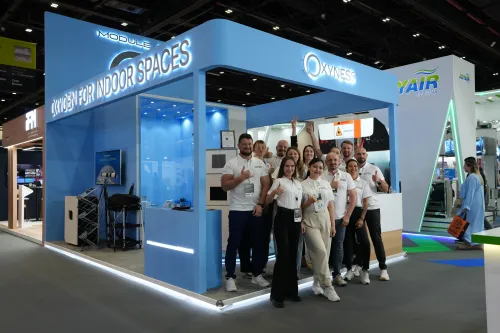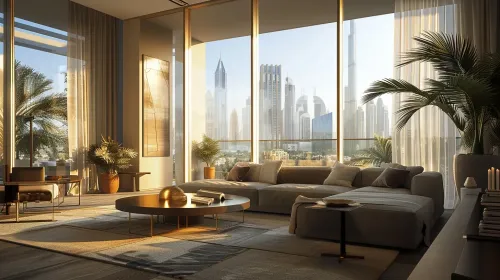The importance of breathing fresh indoor air has become one of the most underestimated health and productivity factors of modern life. In global cities like Dubai, where the temperature often exceeds 40°C, people spend more than 90% of their time indoors — in offices, homes, hotels, and shopping centers. But the reality is that most indoor environments suffer from poor ventilation, oxygen deficiency, and invisible pollutants. Improving indoor air quality is no longer a luxury — it is a necessity for physical health, cognitive performance, and emotional well-being.
Many assume that air conditioning automatically means clean and fresh air. In truth, HVAC systems recirculate the same stale air repeatedly, stripping it of oxygen and natural freshness. The result is a condition often called “indoor air fatigue” — a combination of tiredness, headaches, and mental fog caused by low oxygen concentration and increased CO₂. Maintaining proper indoor air quality in Dubai means restoring oxygen balance, regulating humidity, and eliminating microscopic particles that accumulate in enclosed spaces.
Oxyness represents a new chapter in air wellness — a technology designed to create truly fresh indoor air while maintaining energy efficiency and comfort. It combines purification, oxygen enrichment, and continuous monitoring, delivering environments where every breath supports life, focus, and calm.
Understanding Indoor Air Quality
Indoor air quality (IAQ) refers to the composition and cleanliness of air inside buildings. According to WHO indoor air quality guidelines, exposure to polluted or oxygen-deprived air contributes to fatigue, respiratory irritation, and reduced concentration. The most important indoor air quality parameters include oxygen levels, CO₂ concentration, temperature, humidity, and particulate matter such as PM2.5 and PM10. Managing these parameters is essential for sustainable health and productivity.
Poor indoor air quality is not limited to industrial cities. Even modern apartments and corporate offices with premium air purifiers can experience air imbalance. Without oxygen renewal, the air feels heavy and lifeless, despite being technically “clean.” The challenge is that filtration alone cannot create vitality — it removes dust but not stagnation. To achieve real freshness, we must go beyond filters and apply systems that renew and enrich the atmosphere.
That’s why Oxyness goes beyond traditional air purification. It continuously measures and optimizes indoor air quality parameters while maintaining a healthy oxygen concentration. Its advanced sensors monitor humidity, CO₂, and particulate matter, automatically adjusting airflow and oxygen enrichment to preserve harmony.
Indoor Air Quality Challenges in Dubai
Dubai presents unique conditions that make indoor air management complex. Sandstorms, high humidity, and dense construction lead to continuous dust infiltration. Buildings designed for energy efficiency often rely on sealed windows and heavy air conditioning, which reduces air exchange. As a result, the average oxygen concentration inside Dubai offices and homes can drop below 20%, creating subtle but chronic fatigue.
Typical HVAC systems provide temperature control but not oxygen restoration. This is why many residents and professionals experience sleepiness, poor concentration, and shortness of breath indoors — symptoms directly linked to inadequate indoor air quality.
Local authorities have developed strict indoor air quality regulations that define minimum ventilation rates and pollutant limits. However, real-world compliance varies between buildings. Developers seeking sustainability certifications now include indoor air quality management Dubai programs to ensure healthy environments. Systems like Oxyness meet and exceed these regulations, offering not only purification but oxygen renewal and data-driven air sustainability.
How to Improve Indoor Air Quality
The question of how to improve indoor air quality is central to modern living. There are several proven strategies that work together to create healthier spaces:
Regular air purification and filtration — Removing dust, pollen, and VOCs helps improve indoor air quality by reducing irritants.
Humidity control — Maintaining a 40–60% humidity level prevents dryness and microbial growth.
Oxygen enrichment — Adding oxygen restores freshness and prevents fatigue.
Real-time monitoring — Tracking indoor air quality parameters ensures constant balance.
Natural integration — Using plants, open ventilation, and oxygen-balancing systems creates continuous air renewal.
Oxyness integrates all these steps into one smart system. It not only purifies but also revitalizes the air, maintaining a natural composition similar to outdoor air. This is how to improve indoor air quality sustainably — through a combination of science, design, and nature.
Improving Indoor Air Quality in Office Environments
Corporate spaces are among the most affected by poor ventilation. Workers often report afternoon drowsiness, lack of focus, and eye irritation. These symptoms are not caused by workload alone but by low oxygen and high CO₂ levels — the main indicators of poor indoor air quality.
Improving indoor air quality in office spaces requires both mechanical and biological strategies. Oxyness addresses both: it enhances existing HVAC systems, providing oxygen-enriched, purified airflow directly into work zones. Studies show that improved oxygen levels in offices increase productivity by up to 25% and reduce headaches by nearly 40%. Employees feel more alert, creative, and emotionally stable.
For management teams, investing in indoor air quality sustainability delivers measurable ROI: better focus, fewer sick days, and higher engagement. In Dubai, where corporate wellness is a growing trend, Oxyness has become a benchmark solution for creating healthier workplaces that align with both efficiency and environmental responsibility.
Indoor Air Quality Sustainability and Regulations
The future of wellness technology lies in sustainability — creating systems that protect both people and the planet. Indoor air quality sustainability focuses on improving living and working conditions while reducing energy consumption and emissions. Dubai’s green building codes now include specific indoor air quality parameters and indoor air quality regulations as part of LEED and WELL certification frameworks.
Oxyness aligns with these standards. Its smart control system balances oxygen supply with minimal energy usage, adapting airflow based on occupancy and CO₂ data. This ensures compliance with Dubai Municipality indoor air quality management requirements and supports long-term ecological goals.
Unlike traditional purifiers that need frequent filter replacement, Oxyness operates as an integrated air quality ecosystem. It helps architects and developers meet sustainability criteria, while end users experience tangible comfort — better breathing, clearer thinking, and emotional balance.
Fresh Indoor Air for Residential Spaces in Dubai
Residential environments require just as much attention as offices. In Dubai, most homes are sealed to prevent heat exchange, meaning little fresh indoor air enters naturally. Over time, oxygen levels decline, humidity drops, and pollutants from furniture or cleaning products accumulate.
Oxyness restores this balance. By generating oxygen-enriched airflow, it ensures that indoor air quality Dubai households maintain feels natural and energizing. Residents report deeper sleep, improved mood, and fewer allergy symptoms. The system can integrate discreetly into existing air ducts or operate as a standalone module, making it accessible for apartments, villas, and hotel suites alike.
Homeowners who focus on how to improve indoor air quality often underestimate the psychological effects. Clean air supports emotional well-being as much as it supports physical health. Oxygen-balanced environments create calmness and mental clarity — essential in fast-paced urban life.
Indoor Air Quality Parameters That Define Health
Understanding and maintaining the right indoor air quality parameters is essential for effective management. The main measurable factors include:
Oxygen concentration: ideally around 21% for mental clarity and focus.
CO₂ levels: should not exceed 800 ppm for cognitive efficiency.
PM2.5 and PM10: particulate matter below WHO indoor air quality guidelines levels.
Humidity: between 40–60%, ensuring respiratory comfort.
Temperature: 20–24°C for optimal productivity and comfort.
Oxyness uses real-time sensors to measure these parameters and automatically maintain ideal values. This continuous control creates a consistent experience of fresh indoor air that feels pure, light, and invigorating.
Indoor Air Quality Management Dubai: From Regulation to Reality
The UAE’s Ministry of Climate Change and Environment and Dubai Municipality have established clear frameworks for indoor air quality management. These include monitoring requirements, pollutant limits, and periodic reporting. For developers, compliance is mandatory — but the real opportunity lies in differentiation.
Projects equipped with systems like Oxyness exceed regulatory expectations, offering tenants measurable air quality data and real wellness benefits. In the age of ESG and corporate transparency, indoor air quality management Dubai programs are becoming a key competitive advantage for real estate and hospitality brands.
Hotels, offices, and residential complexes using Oxyness are redefining what comfort means. Instead of simply cooling the air, they deliver environments where freshness, vitality, and sustainability coexist.
The Science of Oxygen Enrichment
Oxygen plays a fundamental role in every metabolic process in the human body. Even a small decrease in oxygen concentration can reduce attention span, cause headaches, and impair memory. Oxygen enrichment counteracts these effects naturally.
By increasing indoor oxygen to outdoor-equivalent levels, Oxyness restores biological balance. This technology has proven benefits: improved cognitive function, reduced fatigue, faster recovery, and overall emotional stability. It is the missing link between air purification and true wellness.
While traditional systems focus on removing harmful particles, Oxyness focuses on restoring vitality — creating living air that sustains performance and happiness. This combination of purification and oxygenation represents a breakthrough in modern environmental health.
The Role of Data in Improving Indoor Air Quality
One of the most overlooked aspects of air management is data. Continuous measurement of indoor air quality parameters allows proactive correction before discomfort occurs. Oxyness integrates smart sensors and cloud-based analytics, giving users real-time insights into oxygen, CO₂, and humidity trends.
This transparency supports both compliance and comfort. For facility managers, it means instant alerts and energy-efficient control. For individuals, it means confidence that every breath is safe, clean, and fresh. Indoor air quality management Dubai projects that implement data-driven systems set new benchmarks for building intelligence and occupant wellness.
Toward a Future of Healthy Buildings
Modern architecture is entering a new phase — one where air, light, and human biology merge into a unified ecosystem. Improving indoor air quality is not just an engineering task; it’s a foundation for sustainable well-being.
Dubai’s skyline already represents innovation and ambition. The next evolution will be invisible — the transformation of air itself. Fresh indoor air Dubai projects equipped with Oxyness will lead this change, creating healthier, smarter, and more human-centered spaces.
As we move forward, the concept of indoor air quality sustainability will define how buildings are designed, managed, and experienced. Systems like Oxyness turn invisible air into a visible advantage — cleaner, fresher, and enriched with oxygen.
Breathe Better. Live Better. Experience Oxyness.
Sources:
World Health Organization — Air Pollution and Health
https://www.who.int/health-topics/air-pollution
Harvard Health Publishing — Oxygen and Brain Function
https://www.health.harvard.edu/mind-and-mood/how-oxygen-affects-your-brain
Environmental Protection Agency — Indoor Air Quality Basics
https://www.epa.gov/indoor-air-quality-iaq
Dubai Municipality — Indoor Air Quality Regulations
https://www.dm.gov.ae/public-health-safety/indoor-air-quality
Nature Scientific Reports — Oxygen and Cognitive Performance
https://www.nature.com/articles/s41598-019-45205-8
European Respiratory Society — Air Quality and Wellness
https://www.ersnet.org/advocacy/air-quality-and-health

Module21 for Your Business

Module21 for Your home





